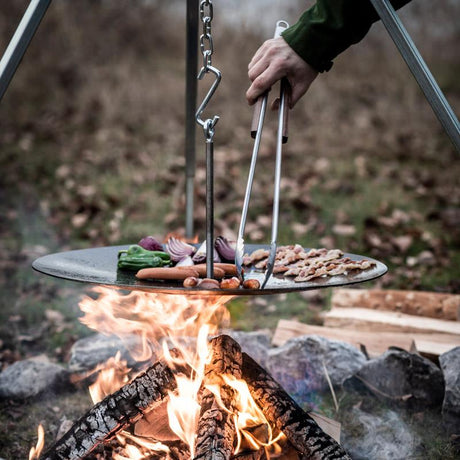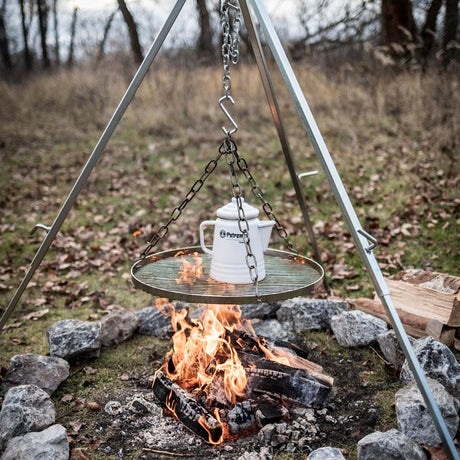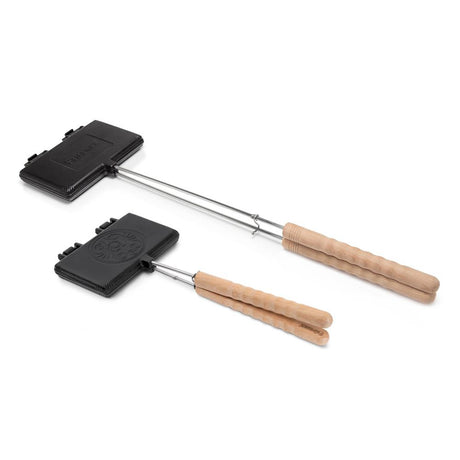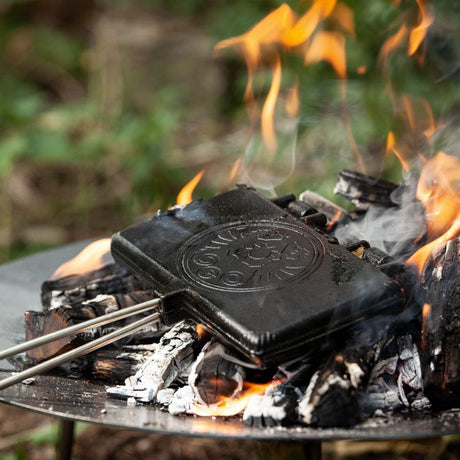Imagine this: You're walking through a beautiful forest, the sun is shining through the treetops and suddenly there's a bear in front of you. Your heart races, your knees go weak - what do you do now? For most of us, an encounter with a bear is an extreme scenario that we can hardly imagine. But with the right knowledge and good preparation, you can not only master this situation safely, but perhaps even remember it as a unique nature experience. In this article, we'll show you what you should do to prevent a scary moment from turning into a dangerous situation.
Table of contents
What to do if you encounter a bear?
Do bears attack people? When does it become dangerous?
How do you find a way out when encountering bears?
How do you avoid food scraps and other bear attractions?
The most important rules of conduct at a glance
Summary
What to do if you encounter a bear?
The moment you come face to face with a bear is definitely not the time to panic or react hastily. Your first reaction in such a situation can determine the outcome of the entire encounter. The most important thing to remember is to stay calm and avoid rushing at all costs.
When you encounter a bear, it is completely natural for your body to immediately switch to fight-or-flight. But this is exactly where the danger lies. Many people instinctively think they have to run away immediately to get to safety. However, this is a fatal mistake. A brown bear can reach speeds of up to 50 km/h - you definitely cannot. Fast, hectic movements can also trigger the bear's hunting instinct and turn a harmless encounter into a dangerous situation.
Instead, you should move slowly and in a controlled manner. Walk slowly backwards without turning your back to the bear. Speak calmly in a normal voice - this may sound strange at first, but it signals to the bear that you are a human and not prey. At the same time, you can make slow arm movements to make your presence clear without appearing threatening.
Do's & don'ts during a bear encounter
| ✅ Right | ❌ Wrong |
|---|---|
| Walk backwards slowly | Run away quickly |
| Speak calmly | Scream or shout |
| Show a large figure | Duck or hide |
| Keep eye contact | Ignore the bear |
Brown bears have very specific behaviors that you should understand. They are naturally curious animals, but usually not aggressive. A typical behavior that is often misunderstood is rearing up on their hind legs. Many people interpret this as a threatening gesture or preparation for an attack. In fact, it is usually pure curiosity - the bear wants to get a better overview and "sniff" you. If a bear stands up, this does not automatically mean danger.
The distance to the bear plays a decisive role in assessing the situation. At a distance of over 100 meters, you are relatively safe and can even enjoy the encounter. Between 50 and 100 meters, you should be careful and retreat slowly. Below 50 meters , extreme caution is required and you should strictly follow all rules of conduct.
Always maintain eye contact with the bear, but do not stare at it provocatively. There is a fine line between remaining attentive and not appearing threatening. The bear should realize that you notice and respect it, but do not challenge it.
Do bears attack people? When does it become dangerous?
The reassuring news first: bears very rarely attack people. Most bears are just as uninterested in a confrontation with you as you are in one with them. Nevertheless, there are certain situations in which an encounter can be dangerous, and you should definitely be aware of these.
The most common and dangerous reason for bear attacks is to protect cubs. A mother bear with her cubs is extremely cautious and will protect her offspring at all costs. If you come between a mother bear and her cubs or get too close to them, the situation can escalate very quickly. Mother bears are particularly unpredictable at this time and often react aggressively to any perceived threat.
Another critical moment occurs when you come between a bear and its food. Bears are opportunistic feeders and can become very territorial when it comes to food. It becomes particularly problematic when bears have already become familiar with human food and see it as easy prey.
Moments of surprise stress bears enormously and can lead to unpredictable reactions. If you suddenly turn a corner and come face to face with a bear, the situation is extremely tense for both you and the animal. The bear has no time to assess the situation and may react defensively or even aggressively.
Typical dangerous situations at a glance
| Situation | Danger level | What to do? |
|---|---|---|
| Mother bear with cubs | 🔴 Very high | Retreat slowly and immediately |
| Bear eating | 🟡 Medium | Make a wide berth |
| Surprise encounter | 🟡 Medium | Behave calmly, talk |
| Curious lone bear | 🟢 Low | Standard rules of behavior |
You can recognize a really aggressive bear by its clear warning signals. A bear that feels threatened or wants to attack will put its ears back, show its teeth and start growling or hissing. Some bears also stomp their paws or make short mock attacks, so-called "bluff charges", to test whether you are really a threat.
How do you find a dodge when meeting bears?
Sometimes the best fight is the one you don't have in the first place. If you encounter a bear, it is often smarter to find a clever way to avoid it than to risk a confrontation. It is important to react quickly and correctly without provoking the bear.
Get a better overview of your surroundings as soon as you notice a bear. Look around you: Where is the nearest safe retreat? Are there any trees you could climb if necessary? However, you should bear in mind that brown bears are also very good climbers, especially young animals. Large, thick trees can still be an option, as heavy, adult bears have problems with thin branches.
Patience is required when retreating strategically. Do not retreat in a panic, but in a planned and deliberate manner.Do not movedirectly backwards, but slightly sideways - this tells the bear that you are not fleeing, but respectfully making way. Keep your movements slow and steady, without jerky actions. You should always keep an eye on the bear and never turn your back on it.
Nature offers you various natural barriers that you can use cleverly. Large rocks not only create distance, but also privacy, which helps both parties to calm down. Dense vegetation can slow down your escape, but also that of the bear. Bodies of water are interesting, as bears can swim but are reluctant to go into the water. Steep slopes can give you an advantage, as you as a human are often more mobile on difficult terrain than a heavy bear.
The aim is always to allow the bear to retreat with dignity without it feeling cornered. A bear that sees no way out is more likely to react aggressively than one that has enough space to leave the situation itself.
How do you avoid food scraps and other bear attractions?
Prevention is and remains the best protection against dangerous bear encounters. It is much easier to avoid attracting bears in the first place than to have to deal with them later. Leftover food is like a personal invitation to dinner for every bear in the area.
If you are camping in bear country, you need to store your food properly. This means that anything that smells or is edible should be hung at least four meters high and at least one and a half meters away from the nearest tree trunk. Use airtight containers to minimize odours . Many experienced campers swear by special bear containers designed specifically to keep bears away.
Your cooking area should never be close to your sleeping area . Experts recommend a distance of at least 100 meters between the kitchen and the tent. Also, never cook directly in the tent, even if the weather is bad. All cooking odors, food scraps and even toothpaste can attract bears and should be properly disposed of or stowed away.
Avoid bear encounters
| Action | Why important? | Practical implementation |
|---|---|---|
| Make noise | Bears hear you coming | Talking, clapping while walking |
| Pay attention to wind direction | Bears have an excellent sense of smell | Go with the wind |
| Set off early | Bears are active at dawn and dusk | Start before sunrise |
| Take garbage with you | Prevent bear habituation | Pack everything, leave nothing behind |
Noise is your friend when you are hiking through bear country. Bears like to hear you coming and will usually avoid contact on their own. Talk while hiking, clap your hands occasionally or draw attention to yourself in other ways. This is particularly important in dense forests or along rivers where visibility is limited or the water drowns out other sounds.
Pay attention to the wind direction when hiking through bear territory. Bears have an exceptionally good sense of smell - about seven times better than a dog. If you walk with the wind, the bear can smell you from a distance and has time to get out of your way. Walking against the wind can lead to surprise encounters.
Respect the bears'territory and recognize the signs that you are moving in their habitat. Large paw prints in the mud, scratch marks on tree trunks or fresh bear scat are clear signs that bears live here. Berry bushes and fishing grounds are particularly popular places for bears to stay and should be avoided if possible.
The most important principle when camping in bear areas is: take everything you have brought with you. Even the smallest scraps of food or garbage can attract bears and cause them to associate human campsites with food. Once a bear has learned that people mean food, it will keep coming back and become a problem both for itself and for future campers.
The most important rules of conduct at a glance
So that you are well prepared for an emergency, here is a summary of the most important points: Keep calm in the event of a direct bear encounter. Never panic or make frantic movements, but instead talk calmly to the bear and use slow arm movements to make yourself noticed. Keep a sufficient distance and retreat slowly without running away, as rapid flight movements can trigger the hunting instinct.
If direct contact does occur, crouch down and place your hands on the back of your neck - this protective position can save lives in extreme cases. As a preventative measure, you should always avoid leftover food and respect bear areas. Also observe the special rules of conduct for encounters with brown bears and learn to correctly interpret warning signals in body language and threatening gestures .
Conclusion: Respect and preparation are the key
You will never forget an encounter with a bear - that's for sure. Whether it turns into an impressive nature experience or a nightmare depends largely on your behavior. The most important thing to realize is that bears are usually just as uninterested in a confrontation as you are. With the right knowledge, respectful behaviour and good preparation, you can significantly minimize the risk of dangerous situations.
Always remember: stay calm, move slowly, keep your distance and never run away. Preventive measures such as proper food storage and respectful handling of bear territory are just as important as the right behavior during an actual encounter. Bears are majestic animals that deserve our respect and caution - with the right attitude and preparation, a bear encounter can be an unforgettable nature experience that you will talk about for a long time to come.






































